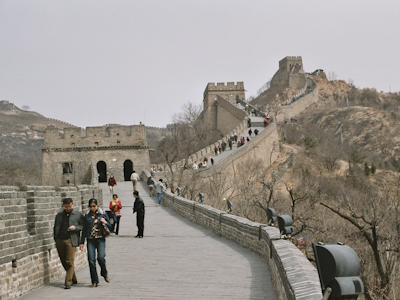Great Wall

The Great Wall is a masterpiece of construction of Ancient China with high symbolic value.
The stone and earthen fortifications in northern China were built originally to protect the northern borders of the Chinese Empire against intrusions by various nomadic groups. As it is "virtually impossible" to guarantee the perfect preservation of the whole length of the wall(s), the conservation is focused on the Badaling section, the western starting point at Jiayuguan Pass and the eastern end at Shanhaiguan.
Community Perspective: To escape the tourist crowds, reviewers recommend hiking stretches of the “wild” Wall or seeking out remote, unrestored portions (although these are not part of the core zone, you will feel that you have properly visited). Solivagant saw the ‘official’ start and end points at Shanhaiguan and Jiayuguan. Tony has shared the latest on the situation at Badaling.



Map of Great Wall
Community Reviews
Tony H.

Last review of the Great Wall on this site is from 2016 so I guess it's good to update how things look like at the wall in the 2020s. I visited the Badaling section of the wall in June 2024.
I took the high speed train from Beijing's Qinghe station which has the most of the high speed departures to Badaling. You can also depart from the Beijing North station. Tickets are very affordable, 20 RMB at the cheapest (one way)! You can book the train tickets even just the day before if you're visiting on a weekday. I booked both the train tickets and the Great Wall tickets through Trip.com on the Alipay app few days in advance. High speed trains have their own station at Badaling and when you exit the train station, you'll see the cable cars that will take you to the up to the north section of the wall. If you want to walk up the wall, you need to go to the opposite direction from the station and walk through the bus parking lot towards the main gate of the wall. The signage wasn't very good around the station as there was big construction going on but I had booked one-way ticket for the cable car so that's where I headed. There weren't queues at all on a Tuesday afternoon so I was very fast going up to the mountains, after picking up physical tickets from the ticket counter (no passport used here for entrance like in Forbidden City).
Badaling is the most visited part of the wall and the north section is the most visited part in Badaling itself. Up on the wall there were a lot of people but it was still far from being uncomfortably crowded. The cable car doesn't take you all the way to the highest tower but you still have quite a hike to reach the tower from the cable car station. If you are strict on time, you can visit the wall in 30 minutes if you take the cable car back down from here. I walked down and with many stops to take photos of the stunning landscape it took me 2 hours to come down to the main gate of Badaling. During the walk you have lots of time to wonder, how was all this built on these steep mountain sides! The wall continues far in the distance and looks so mystical winding up and down the mountains. This area is also a Unesco Geopark so there are information signs about the geology of the region along the wall trek but almost no information at all about the wall itself. If the walking on the wall gets too much on your feet, you can walk next to the wall on an easier path.
After getting back down from the wall, I had lunch at the "cultural village" that has been built between the main gate and the high speed station, which is full of souvenir shops, restaurants and photography studios for photo shoots in traditional costumes. Since I had time until my return train to Beijing, I went to try if my ticket got me still access to the southern section of the wall and the funicular that takes you up there. After a google translated conversation at the south entrance's ticket counter, I was let to the funicular with a little extra 40 RMB fee. I took the last funicular of the day up the mountain and I was the only one on it. The southern section is much shorter than the northern section and it takes less than an hour to walk down. I had at moments the whole wall just for myself here, only few other visitors were here after 4.30pm when the funicular and the cable car stop operating. I have to say that the views from the southern section aren't as amazing as from the northern section but if you want to avoid the crowds in Badaling this is the section you should choose! After I was once again back down at the main gate I walked back to the train station to catch my return high speed train back to Beijing.
Badaling does have a certain Disneyland vibe with all the shops, toboggan rides, animal parks and night light shows but I don't think the renovation work on the wall itself has gone too over the top. The wall looks authentic and not too different from the unrenovated parts that you can see in the distance (take your binoculars with you if you want to marvel them properly!). Hopefully in the future I get chance to visit other parts of the wall!
Michael Turtle

The Great Wall of China is obviously one of the most impressive landmarks ever built by man. But there are lots of ways to visit it and the quality of the experience will vary a lot.
Accessing the wall from Beijing, Badaling is the easiest section but it's also the most crowded. Expect a typical tourist experience. I prefer Jinshanling which is also relatively easy to get to but has a few less tourists because some of the bits are quite hard to climb.
What I would really like to do next time is go much further from Beijing to some sections that get only a few visitors.
Read more from Michael Turtle here.
Tom Livesey
I walked on the Great Wall in December 2010. Beijing's bitter winter made it a memorably cold WHS visit - indeed it is joint coldest in my mind with Denmark's Kronborg Castle, which I visited in a more recent winter. The thing that surprised me the most was just how steep the wall is. I checked-in at the tourist-heavy entrance at Badaling, though in the winter it wasn't overly busy at all. It’s about 90 minutes drive outside of Beijing, and a real contrast to the densely-packed, smog-choked metropolis.
Read more from Tom Livesey here.
Kyle Magnuson
California - United States of America - 05-Apr-15 -

I've visited the Great Wall on 3 separate occasions. Two visits to Badaling, and one visit to Huanghuacheng. While Badaling is the "tourist wall" it is undoubtedly stunning, particularly if its not filled with people. (weekdays/no holidays, etc.) Huanghuacheng is something altogether different. When I visited in 2007, this portion of the wall was half ruined and after 3-4 hours of hiking the wall, I came across less than 10 people. The degree of incline at this section of the wall is something to marvel at, indeed on a couple occasions I had to practically crawl. While Badaling provided stunning views, Huanghuacheng was an exhilarating experience that I'll never forget. The fact that I had this amazing wonder nearly all to myself is something quite extraordinary.
Like some on this forum I would very much appreciate a clarification on what exactly is inscribed concerning the Great Wall world heritage site. I am of the opinion, to inscribe the whole damn thing, and work with China to start suggesting which portion require immediate attention, which areas need management plans, buffer zones, and visitor facilities.
My visits all occurred in 2006 and 2007, so one wonders what is the current condition of Huanghuacheng? Have they restored this tremendous section of the Great Wall, is that
a bad thing or a good thing?
Read more from Kyle Magnuson here.
Clyde

I visited this WHS and world wonder in October 2013. I opted for the scenic Mutianyu Great Wall since I wanted to avoid the massive crowds of Badaling and because I love to take photos. I went up and down by ropeway and I walked all the way from Tower 1 to 23 (and beyond where the wall is less reconstructed). The golden hour at sunset is incredible since I visited in Autumn and the foliage colours matched the sunset rays on the Great Wall. A magical place indeed!
Ian Cade

Well it didn't disappoint. This is one of the World Heritage Sites that I always reel off when people ask me what places are included on this list I am so obsessed with. Now after my first visit I can fully understand why this is one of the most famous places in the world. I really enjoyed the 3 or 4 hours I had getting my first stroll along the Great Wall and would love to come back and visit some more stretches of it, especially the remoter parts out west. It is pretty amazing seeing how the wall winds over the top of hills for mile after mile. The topography of the landscape really highlights what an astounding undertaking it was to build such a significant structure, it is impressive just seeing this short stretch and become almost baffling when you take into account just how long it is.
I visited as part of a day trip from Beijing, and despite the numerous factory stops and the distinctly underwhelming Ming Tombs I have a really good memory of this visit. I visited the stretch at Mutianyu, which is restored and a little touristy at the base, however the number of people on the Wall proper was very manageable and I even got a few stretches between towers where we were the only visitors. (NB it seems that Mutianyu is not actually listed in the UNESCO documents as part of the inscription, however there are several WHS symbols around the site and on the tickets so I feel I have properly visited this site).
Sometimes the context of a visit really adds to it, and here was no exception. The crowds were light, the weather fantastic and my tour also enabled me to have the company of a lovely couple from Madrid, who were happy to pace around the wall with me chatting and handing out some Spanish biscuits making the visit much more enjoyable.
I really did enjoy my time here and would happily return to walk some more parts of the wall; the day tours from Beijing can provide a decent chance to get a first taste of it, and also set off thoughts of returning to see a lot more of this huge site.
[Site 8: Experience 8]
Stephen Brooker
I was lucky enough to spend a week, during which we saw no other European faces, walking various sections of the Ming Great Wall.
It is impresive, unfortunately most visitors only go to the, over restored, tourist traps of Badaling and Mutinayu, and so miss the best of the wall. If you can only visit one stretch, then go to the Jinshanling section and walk along it to Simitae. This stretch is also wonderful in that it has been nicely conserved rather than restored.
It is also worth considering that the label Great Wall is misleading. It would probably more accurate to talk of the Great Walls (plural) of China. It has been rebuilt on at least three occaisions; Qin, Han and Ming Dynasties, each of which essentially built a new wall, along a new route, often completely different. In addittion the wall is often doubled or even trebled, and has spurs etc.
For this reason no one can give an accurate length for the wall.
Verdict: To get the best from the Wall, put on your hiking boots.
Els Slots

I visited the Great Wall of China on two occasions: first in 2004 near Beijing and the second time in 2007 near Dunhuang in Gansu Province.
To make the first trip, I joined one of the daily 50 yuan tours that start from Qianmen. The guide started chattering (in Chinese of course) right from the start and didn't stop for the first hour (without breathing, was my impression). Besides me, our group consisted of mainly male Chinese daytrippers. That gave them some interesting photo material - themselves and me on various parts of the Wall.
Our first Wall-stop was at Juyongguan. I was really happy when I got off the bus: so this is it! One of the most exciting moments in a travellers life. First impression: it's really very steep to walk to one of the watchtowers. And it's a really strange feeling to stand here: like the Taj Mahal, you're so familiar with its looks that you don't know what to think of it.
The other stop was at the infamous Badaling-site. Here it's all quite touristy, but not too bad this time of year. They also have a Great Wall museum where they exhibit (among other not too interesting stuff) the Unesco World Heritage inscription document.
A very different experience is visiting one of the wall sections in the outer provinces. There are a few of them in Gansu. On a cold November morning, I headed out for the Yumen-pass. Close to that monument of Silk Route fame is a stretch of the Great Wall dating from the Han dynasty. Desert, desert is about the only thing you see here for hundreds of kilometers. And then there's the outline of a wall and a beacon tower. The wall here was made of loess and reed, which has been preserved well.
Rajeev Aloysius
The Great Wall at Ba Da Ling is one of the most common tourist spots in China. The crowds are huge, with its own highway exit. You do get to see other, different parts of the wall on the road there or back, that are more beautiful, or unrestored and therefore more awe inspiring.
The climb is quite steep, but not too bad compared with other parts of the wall that we saw from the road. The more adventurous tourist should turn left at the first entrance after buying the ticket, and this has better views and better photo opportunities. There were some in our group that were staying at the Badaling Hotel in order to visit different parts of the wall all week, but I was not keen enough to do that! I took a Grayline Bus tour, and the Chinese lady guide spoke impeccable English.
Chi Cheung
It seems like you went to one of the very touristy portions of the great wall. The wall is thousands of kilometers long, you can go to one of the unrestored portions. Even near Beijing, there are parts that have been relatively unrestored since the Ming Dynasty. For instance, the Simitai is relatively untouched. You can walk along some amazing portions, and camp on the wall itself (or in the towers).
Solivagant

WHS enthusiasts might be interested in details of the 2 “extremities” of the Great Wall at Shanhaiguan and Jiayagaun - called by the Chinese “First door under the heaven” and “Last door under the heaven” to indicate the passage away from/to the non-Chinese “barbarian” lands) respectively.
As indicated by other reviewers, the sections of the Great Wall around Beijing are very touristy and crowded (particularly with Chinese) and heavily restored. The Government has opened several locations to try to relieve the pressure from the “original” at Badaling and we have visited some of these on different visits. Each is certainly worth going to despite the carnival atmosphere.
The town of Shanhaiguan contains “The First Gate” but the true end/start of the wall is a few kms away on the shore of the Bohai Sea. It too is heavily restored but it is quite nice to literally see the wall going “into” the sea. This is seaside for the Chinese and it gets very crowded. We experienced a wonderful example of the need to “dot all the is and cross all the ts” (or whatever the equivalent is in Chinese characters) when our taxi driver from town explained that the price we had carefully negotiated was in fact only for 1 way! The Jinshan Guesthouse also holds our record as the dirtiest hotel in China. The uncaring, noodle slurping staff were quite happy to give us a bucket and mop for us to be the first people to clean our bathroom in weeks
Our preference as the most “atmospheric” location is at Jiayaguan. Not at the enormous reconstructed fort but a few kms away where the mud wall which extends from the fort ends in a mound above a ravine which drops down to a river – this is all that is left of the last watch tower on the wall. Beyond is desert as far as the eye can see. We took a delightful little 3 wheel taxi along dirt tracks and were virtually the only people there to sense the “end of the civilised world” (photo)
(Trivia Question :- Which is the “longest” WHS? Well the “length” of the Great Wall of China is stated generally as being around 6000kms although other estimates including all its many branches go as high as 50000kms! I have however had some difficulty in establishing just how far apart the 2 “traditional” extremities described above are (Some sources, however, extend the wall as far east as the Yalu river). Based on a great circle distance for 20 degrees of longitude at an average 40 degrees north these 2 points are around 2350 kms apart. The 2 furthest points of the Struve Geodetic Arc, newly inscribed in 2005, are stated as being 2820kms apart. So in terms of “straddling” the Earth’s surface it looks as if the Arc just gets it!)
Ben Pastore
Like many others before me, my visit to the Ba da ling portion of the Wall was a prepackaged, escorted trip including the mandatory tourist traps. That aside, it truly is a marvel of engineering if only to build on such rugged and inhospitable slopes. Supposedly Chairman Mao said "A real man climbs the Great Wall". Well, that may be true, but I say "A real man may climb the wall, but a smart man takes the tram and walks down." Seeing the beige ribbon stretch out to the horizon does make one appreciate why it belongs on the list. Going to China without seeing the Great Wall would be like going to Paris and not seeing the Eiffel Tower. You just have to do it.
C H Ho
Hong Kong, China - 01-May-05 -
I visited Munyungyuan near Beijing, which is 1 of the famous tourist sites for the Great Wall. There are many towers on the wall. You can stand any tower which is at the top of the mountain ridge and feel like the famous Chinese sentence from Qin's King Shin Huang,"Everything was under my feet".
Rob Wilson
My friends and I walked from Jingshanling to Simatai. It was 10km of hard slog, in a 40 degree heat! But, it was worth every step. This part of the Wall is relatively unrestored and is, at times, treacherous.
Walking the wild Wall is an experience that I'll never forget. Don't go to the tourist wall, head somewhere like this - you won't regret it for a second.
One of the most memorable experiences of my entire life.
Community Rating
- : Jon Bauer Khuft Walter Kyle Magnuson Jan Zimmermann Col Zhenjun Liu Thibault Magnien Craig Harder Randi Thomsen Jeffrey Chai Ran Alexander Barabanov Alexander Parsons Stanislaw Warwas DAB Ralf Regele Sachin YAO WEI Antonio J. Michael anak Kenyalang Dennis Nicklaus Christravelblog Maciej Gil Violeta Jakecarlson Yinming Zhang BH Palimpsesto HaraldOest NonDuality AT8 Dorejd 50pagesofshawn Ailton007 Panacci Rogerding Hanming Philipp Leu Travelure Dejulis@hotmail.com Kbtwhs Priyaranjan Mohapatra Inomusay Mihai Dascalu Ovalarezo Adrian Turtschi Fmaiolo@yahoo.com Nathan Cutecid Gordon Mitchell AGuzzo Amitlchoudhuryjbp GatorTravel StaziG Alygeddon Maskyfer Bluewonder310 Marinemajor Casey Laurine Alejandro Lau Ssong.x Awestix Tourb Collisions Javier KngAlaric
- : Mikko Tony H. Philipp Peterer Peter Lööv Peter Alleblas Clyde Nan Svein Elias Xiquinho Silva Chenboada Zoë Sheng Luke LOU Shandos Cleaver Lucio Gorla Drk9Stormy Carlo Sarion Byronb Timonator Richard Stone Yiqun Jin JobStopar KoenigMarke AFisher Allnamesused GerhardM Shwabb1 J_neveryes Federico P. Oscar Wu Trekkie900 Halryder
- : Solivagant Ian Cade Frederik Dawson DL Baiqitun Stanimir Koen Vliegenthart Alexander Lehmann Dwight Zehuan Xiao Merveil VLabhard M.HATADA Beckyjzw Eateateat JoStof Tingmelvin RahulSharma KeithBailey Everett Marie CeeCeeSR Csaba Nováczky Velvetlapis ReallyDeepThoughts
- : Els Slots Chalamphol Therakul Kevin McFarland Dotori Alex Marcean Julio Moreno Rodinia Juropa Pchxiao Mauralin13 Xtopher33 Kelseyyurek JR's HERITAGE SITES
Site Info
Site History
1987 Inscribed
Site Links
Unesco Website
Official Website
Related
In the News
From the Forum
Connections
The site has 40 connections
Constructions
Damaged
Geography
History
Individual People
Literature and Film
Timeline
Trivia
WHS Hotspots
WHS Names
WHS on Other Lists
World Heritage Process
Visitors
674 Community Members have visited.
